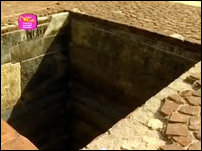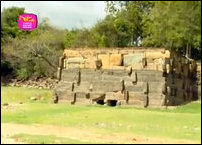Know the Etymology: 397
Place Name of the Day: Monday, 06 April 2015
Bisokotuwa, Biso-uyana
பி3ஸோகொட்டுவ, பி3ஸோ-உயன
Bisōkoṭuwa, Bisō-uyanaBisoa+kotuwa
Bisoa+uyana
The water releasing structure (of the tank)
The royal park or the anointed queen's park
| Bisoakotu1 |
the structure through which the water of a tank goes out; two square and well like structures that reduce the speed of the water of a tank when the water is released through the sluice (Sinhala, Sorata). This is a hollow structure, sometimes two structures in succession, built at the inner side of the dam to calm the water coming through the sluice. The purpose is to protect the dam and sluice from the force of the water released. See Bisoa 1.
|
| Bisoakotu2 |
the square enclosure-like structure built on the top of a stupa, around its spire (Sinhala, Sorata). Bisoa in this context is of the meaning anointing, as the spire of a stupa is anointed by sprinkling sacred water. See Bisoa 2
|
| Bisoa1 |
coming out, pouring out, streaming out; the spot that pours out or streams out; Bahisekaya, Pitata væhireema hoa væhire'na tæna (Sinhala, Sorata); Bihi: out, extraneous, outward, outer, outside (Sinhala); Bihi-dora: outer door or gate of a house, portico in front of a house or mansion (Sinhala); Bahi, Bahir: out, outside, outer, outward (Sinhala); 1. Poas, Poas-ar: doorway, entrance (Toda, DED 5354); Hosilu: doorway (Kannada, Mahadevan, 2003, p.579); Pocil: threshold, gate, entrance (Tamil, Brahmi inscription, Chittanna-vaasal, I. Mahadevan, 2003, p. 385, 579); related to Vaasal, Vaayil in Tamil and Vaasala, Vaahala in Sinhala meaning gate, doorway, entrance, threshold etc. (DED 5354); 2. Bahis: outside (Sanskrit, CDIAL 9186); Bahi: outside (Pali, CDIAL 9186); Bahir-dvaara: outer gate (Sanskrit, CDIAL 9185); 3. Peechchu, Pisukku: to squirt, to syringe (Tamil, DED 4215); 4. Veesu: to throw, spill, open out (Tamil, DED 5450); Beesu, Bisu: to swing, turn round, whirl (Kannada, DED 5450); Visai: to cause to move swiftly, leap, hop, bust, be forceful (Tamil, DED 5450); Veesi-kara'nawaa, Veesu-kara'nawaa: to throw (Sinhala)
|
| Bisoa2 |
anointed queen (Sinhala); Bisew: anointing, royal unction (Sinhala); Abisew, Abhiseka: anointing, royal unction, sprinkling (Sinhala); Abhisheakya: sprinkling, to be anointed (Sanskrit, CDIAL 532); Abhisheka: consecrating a king (Sanskrit, CDIAL 531)
|
| Kotuwa1 |
enclosure (Sinhala); barn, cage, Kooduwa (Sinhala, Sorata); 1. Koadu: stronghold (Tamil, DED 2207a); Koaddai: fort, castle (Tamil, DED 2207a); Kottage, Kottige: barn, room, cattle stall (Kannada, DED 2058); Koddam: basket made of rattan (Tamil, DED 2060); 2. Koodu: birdcage, receptacle for grain, dome, kennel (Tamil, DED 1883); receptacle, nest cage (Malayalam, DED 1883)
|
| Kotuwa2 |
waterspout (Sinhala, Sorata); Kotu-atu, Kotu-pat: narrow passage (Sinhala, Sorata); Koddu: channel that come out of a tank (Eezham Tamil, Vanni); 1. Koddu: anything that is hollow inside, hollow trunk of palmyra palm etc. (Eezham Tamil, Kathiraiverpillai, see column on Kodduk-ki'na'ru); waterspout in irrigation (Eezham Tamil); Kudai: (verb) to hollow out, scoop; (noun) anything hollow (Tamil, DED 1660); Kudaivu: hollow, cavity (Tamil, DED 1660); Koadi: outlet of a tank (Kannada, Telugu, DED 2197); a passage to carry off excess of water (Kannada, DED 2197); Koati: weir of a tank, outlet for surplus water (Tamil, DED 2197); 2. Koddu:(verb) to pour forth, shower down, throw into a vessel (Tamil, DED 2065); (noun) pouring, emptying (Tamil, DED 2065); Koddam: flowing, pouring (Tamil, DED 2065);
|
| Uyana |
(singular), Uyan: (plural and combinations) royal garden, garden (Sinhala); Udyaana: going out, park, garden (Sanskrit, CDIAL 2052); Uyyaana: park, garden (Pali, CDIAL 2052)
|

Exterior and interior of the Bisokotuwa of a ruined tank [Image courtesy:Rupavahini]
Bisokotuwa is a special kind of sluice structure found built in some ancient tanks of the island.
This is usually a square sturdy structure or enclosure built on the inner side of the dam of a tank, at the point of the sluice. The water with its full pressure first goes into this hollow structure through an opening at the bottom on the front side and is released into the sluice tunnel through an opening at the backside.
When water enters into this chamber with full force and jumps up, the pressure and speed are considerably reduced when it comes out through the backside opening. Sometimes water passes through two such chambers, one after the other for doubled effect of calming, before coming out through the sluice gate.
The purpose of the device is to protect the dam and the sluice gate from the force of the water released.
* * *Kotuwa in Sinhala means an enclosure, cage as well as a waterspout. All the meanings are applicable in the case of Bisoa-kotuwa. In meaning an enclosure, Kotuwa is related to Koaddai in Tamil (DED 2207); in meaning a cage or barn-like structure it is related to Koodu in Tamil (DED 1883) and Kottige in Kannada (DED 1883, 2058), and in meaning a waterspout the Sinhala word corresponds to Koddu meaning hollowness in Tamil, related to the root Kudai (DED 1660). See box above.
* * *The word Bisoa in Sinhala has two meanings.
In the context of the sluice structure, Bisoa means coming out, pouring out, streaming out, or the spot where such acts take place. Sorata's Sinhala dictionary says, “Bahisekaya, Pitata væhireema hoa væhire'na tæna.”
In such a meaning, Bisoa is related to other Sinhala words Bihi, Bahi and Bahir meaning outward, and Bihi-dora meaning outer gate.
In meaning a gate, Bisoa corresponds to Poas in Toda/ Dravidian meaning a doorway (DED 5354). A cognate Posil is found used in old Tamil Brahmi inscriptions, in the meaning entrance or doorway (Mahadevan, 2003, p.385, 579). Kannada has a word Hosilu in the same meaning. All of them are related to Vaasal/ Vaayil in Tamil/ Dravidian and Vaasala/ Vaahala in Sinhala, meaning a doorway or gate.
There are also Sanskrit cognates Bahis meaning outside and Bahir-dvaara meaning outer gate (CDIAL 9185).
Another possibility is that Bisoa in its meaning streaming out corresponding to Veesu-kara'nawaa in Sinhala meaning throwing out, and in turn corresponding to Veesu in Tamil meaning the same and Beesu, Bisu in Kannada meaning the whirling act taking place in the sluice chamber (DED 5450).
In its second meaning, Bisoa in Sinhala stands for an anointed queen. Other related words in Sinhala are Bisew and Abisew, meaning the act of anointment or royal unction that involves sprinkling of water. In such a meaning, Bisoa is related to Abhisheaka in Sanskrit (CDIAL 531, 532). The spire enclosure of a stupa is called Bisoa-kotuwa, probably because of the act of sprinkling water during consecration.
* * *Uyana in Sinhala meaning a park or royal garden is related to Udyaana in Sanskrit and Uyyaana in Pali, meaning a park or garden.
Going out was the original meaning of Udyaana, found in the Atharva Vedic usage of Sanskrit (CDIAL 2052).
* * *Bisoa-kotuwa is in Padaviya division of Anuradhapura district.
Bisoa-uyana is a place in Medirigiriya division of Polonnaruwa district
* * *Some related place names:Bisoa-bandaara-gama: The village of the anointed prince or the village of the anointed queen's son; Medirigiriya division, Polonnaruwa district
Bisoa-wela: The royal paddy fields or the paddy fields of the anointed queen; Galigamuwa division, Kegalle district
* * *Uyana:Aasiri-uyana: probably the shelter park or protected park; Kaduwela division, Colombo district
Uyana: The park; Moratuwa division, Colombo district
Egoda-uyana: The opposite side park; Moratuwa division, Colombo district
Uyan-kælea: The park-forest; Panadura division, Kalutara district
Mahawæli-uyana: The park on the side or the Mahawæli River; Kandy Four Gravets division, Kandy district
Uyan-watta: The park garden; Harispattuwa division, Kandy district; Matara Four Gravets division, Matara district; Mawanella division, Kegalle district
Karagoda–Uyangoda: The park bank in Karagoda or the twin villages the Kara shrub bank and the park bank; Kamburupitiya division, Matara district
Mæda–Uyangoda: The park bank in the middle; Thihagoda division, Matara district
Uyan-galla: The park hill; Ganewatta division, Kurunegala district
Kudaa-Uyangalla: The smaller part of the park-hill village; Ganewatta division, Kurunegala district
Uyan-dana: The park place; Mallawapitiya division, Kurunegala district
Wanamal-Uyana: The wild-flower park; Thirappane division, Anuradhapura district
Laksha-Uyana: The charming park or the designated park; Thamankaduwa division, Polonnaruwa district
First published: Monday, 06 April 2015, 21:42
Previous columns:








